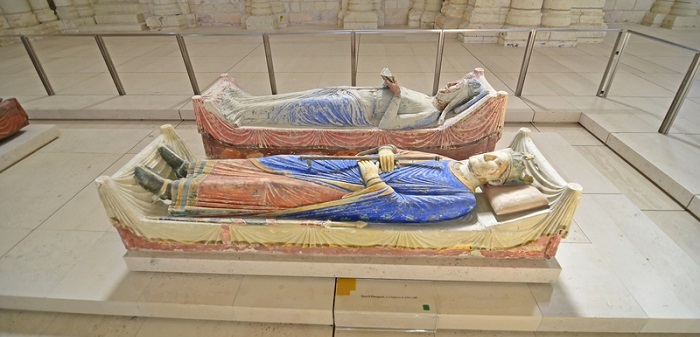

The Royal Tombs of Fontevraud Abbey are a remarkable historical site located in the Loire Valley of France. They are the final resting place of several members of the Plantagenet dynasty. The abbey has a rich history and is of significant cultural and historical importance. The abbey was founded in the early 12th century and became one of the most powerful monastic orders in Europe. Today, it is a UNESCO World Heritage Site and attracts thousands of visitors every year.

The tombs of King Henry II of England and his Queen Eleanor of Aquitaine at Fontevraud Abbey
The abbey was founded in the early 12th century by Robert of Arbrissel, a Breton priest who had a reputation for his piety and his work with women. The abbey was initially intended to be a place of religious devotion for women and was established as a double monastery, which meant that it housed both men and women. The first community of nuns was established in 1101, and by the mid-12th century, the abbey had become one of the most powerful monastic orders in Europe.
The abbey was patronized by the Plantagenet dynasty, who ruled England and parts of France from the late 12th century to the early 13th century. King Henry II and his wife Eleanor of Aquitaine were strong supporters of the abbey, and they made significant contributions to its construction and maintenance. Their son, King Richard the Lionheart, was also a supporter of the abbey, and he was buried there in 1199.

Medieval Royal Abbey of Fontevraud
During the French Revolution, the abbey was suppressed, and many of its buildings were destroyed. The tombs of the Plantagenet dynasty were damaged, and their effigies were removed. The abbey was later used as a prison, and during World War II, it was occupied by German troops.
In the 20th century, the abbey was restored, and its importance as a historical and cultural site was recognized. It was declared a UNESCO World Heritage Site in 2000, and it is now open to the public as a museum and cultural center.
The Royal Tombs of Fontevraud Abbey are an essential part of Angevin history, as they provide invaluable insights into the political and cultural history of the period. The Plantagenet dynasty, which ruled over England and France during the 12th and 13th centuries, played a crucial role in shaping the political and cultural landscape of Europe during the Middle Ages. The abbey's association with the Plantagenets began when King Richard the Lionheart chose to make Fontevraud Abbey his final resting place. This decision set a precedent for subsequent Plantagenet monarchs to be buried at the abbey.
Over the next two centuries, several Plantagenet monarchs, including King Henry II, King Richard I, King John, and King Henry III, were buried at Fontevraud Abbey. These tombs are among the finest examples of medieval funerary art, featuring intricately carved effigies of the monarchs dressed in the clothing of the period. They provide valuable insights into the art, culture, and politics of the Angevin period, and help us to understand the visual language of medieval art.
The royal tombs also provide a window into the wider political and social context of the period. For example, the tomb of Aliénor d'Aquitaine, the mother of King Richard the Lionheart, is located at Fontevraud Abbey, although her body was never interred there. Her tomb provides valuable insights into the role of women in the Angevin dynasty and their contributions to the political and cultural life of the period.
The Royal Tombs of Fontevraud Abbey are the final resting place of several members of the Plantagenet dynasty. The most notable of these are King Henry II, his wife Eleanor of Aquitaine, and their son Richard the Lionheart. Other members of the dynasty who are buried at the abbey include King John and his wife, Queen Isabella of Angoulême. The effigies of these monarchs are some of the finest examples of medieval funerary art and provide valuable insights into the dress, hairstyles, and symbols of the period. The tombs are located in the abbey's church, which is an impressive example of Romanesque architecture.
In addition to the Plantagenet monarchs, several other notable figures are buried at the abbey. These include Isabella of Brittany, the daughter of King John, and Richard, the illegitimate son of King Henry II. The abbey also contains the tomb of Aliénor d'Aquitaine, the mother of King Richard the Lionheart, although her body was never interred there.
The Royal Tombs of Fontevraud Abbey are a remarkable historical and cultural site that provides valuable insights into the art, culture, and politics of the Angevin period. The abbey's association with the Plantagenet dynasty and its rich history make it an essential destination for anyone interested in medieval history and culture. Today, the abbey is open to the public as a museum and cultural center, attracting thousands of visitors every year.
Q1. Is Fontevraud Abbey still an active religious site?
Ans. No, Fontevraud Abbey was suppressed during the French Revolution, and it is no longer an active religious site. Today, it is open to the public as a museum and cultural center.
Q2. Can visitors still see the damaged tombs of the Plantagenet monarchs?
Ans. The tombs of the Plantagenet monarchs were damaged during the French Revolution, but they have since been restored. Visitors can still see the tombs and effigies in the abbey's church.
Q3. What is the significance of the abbey's Romanesque architecture?
Ans. The Romanesque architecture of Fontevraud Abbey is significant because it reflects the style of the period and provides valuable insights into the construction techniques used in the Middle Ages. The abbey's church is considered one of the finest examples of Romanesque architecture in France.